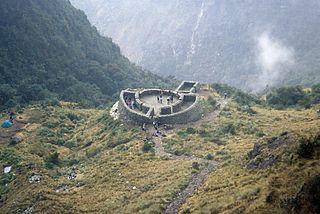| Maranniyuq | |
|---|---|
| Highest point | |
| Elevation | 4,520 m (14,830 ft) [1] |
| Coordinates | 13°58′59″S71°40′35″W / 13.98306°S 71.67639°W Coordinates: 13°58′59″S71°40′35″W / 13.98306°S 71.67639°W |
| Geography | |
| Location | Peru, Cusco Region, Acomayo Province |
| Parent range | Andes |
Maranniyuq (Quechua maran batan or grindstone, -ni, -yuq, suffixes, [2] "the one with a grindstone", also spelled Marannioj) is a mountain in the Cusco Region in Peru, about 4,520 metres (14,829 ft) high. It is situated in the Acomayo Province, on the border of the districts Acomayo and Acos. [3]

The batán is a kitchen utensil used to process different kinds of foods in South Asian, South American and Andean cuisine. It has a flat stone and a grinding stone called an uña. The uña is held in both hands and rocked over the food in the batán. Depending on the process wished, the uña's weight is slightly held back, let loose over, or pressed on. The rocking movements also vary depending on the procedure. The grinding is done dry or with water or oil. The batán has been used since before the arrival of Spaniards in South America.
In linguistics, a suffix is an affix which is placed after the stem of a word. Common examples are case ending, which indicate the grammatical cased of nouns or adjectives, and verb endings, which form the conjugation of verbs.
An intermittent stream named Paqlla Wayq'u originates south of Maranniyuq. It flows to the west as a right affluent of the Apurímac River.

The Apurímac River rises from glacial meltwater of the ridge of the Mismi, a 5,597-metre-high (18,363 ft) mountain in the Arequipa Province in the south-western mountain ranges of Peru, 10 km (6.2 mi) from the village Caylloma, and less than 160 km (99 mi) from the Pacific coast. It flows generally northwest past Cusco in narrow gorges with depths of up to 3,000 m, twice as deep as the Grand Canyon in the United States, its course interrupted by falls and rapids. Of the six attempts so far to travel the Apurímac in its full length, only two have been successful.








